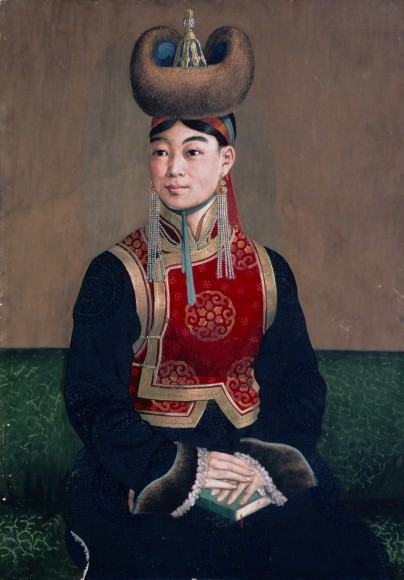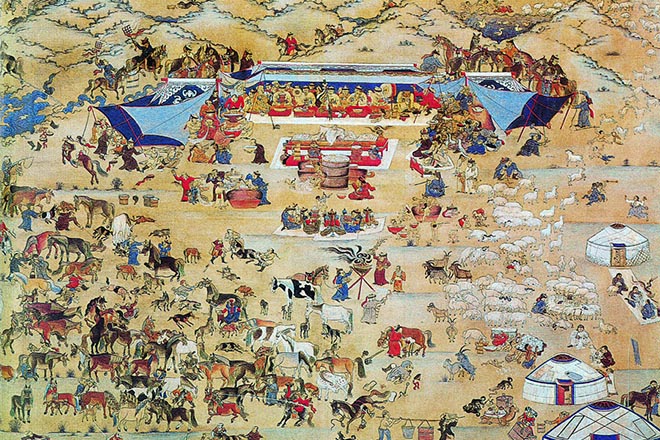What Kind of Art Arcitectures Did the Mongles Have
Visual Fine art of Mongolia
Movie theatre, the phenomenon of the 20th century, came to Mongolia in 1910s. First movies were shown in the upper-case letter metropolis, at the American Consulate and Russian Stock Substitution's hotel. In 1913 Mongolian prince Namnansuren is known to have brought some films from Russian federation to prove at the residence of the Bogd Khan. Subsequently the revolution of 1921, equipment and movies accept been purchased and students trained in Russia . Thus people accept caused access to cinema. At that time, cinema in Mongolia was called "Shadow show", and it was complimentary of accuse, until the first cinema theatre "Ard" was congenital in 1930s. In 1935, under the decision of the Council of Ministers, a movie product company "Mongol kino" was set up up with Soviet assist. The get-go production of the visitor was a documentary "74th Celebration of 1st May". In 1936, the commencement characteristic movie created with the technical assistance of the Soviet "Lenfilm". Mongolia 's first picture directors, cameramen, editors and other personnel were trained on the job past professionals from the Soviet Spousal relationship . And in 1938 Mongolians were able to make independently "Norjmaa's way", and "Wolves" in 1939. Movies directed by the famous Mongolian film director D.Jigjid, such as "Tsogt taij" (1945), "People'due south messenger" (1959), "Flood", "Son-in-constabulary" and others have became classics of Mongolian cinema. Film directors of younger generation, such as H.Damdin, Ts.Navaan, Ch.Gombo, B.Baljinnyam, B.Sumhuu and O.Urtnasan have made their unique contribution to further evolution of Mongolian movie house. The 1990s have became a turning bespeak in the history of Mongolian cinema. Around 20 private film studios that accept emerged between 1992 and 1997, produced more than than 100 feature movies. Strange relations with films companies have expanded also. Joint productions of both documentary and feature films with French, Japanese, Chinese and Mongolian film producers have successfully participated in diverse international movie festivals. Fine arts of Mongolia are famous for its incredible paintings. Cave paintings aged 3-8 thousand years and found in the Khoid Tsenkher cave, Munkhan somon of Khovd aimag, are considered the first works of art discovered in the territory of Mongolia . The history of fine art and architecture of the Mongolian Empire begins in the twelfth century and at later times was influenced by other nations. The majuscule city of the Mongol Dynasty, Khar Khorum, was a magnificent proof of the glory and majesty of the Mongolian Empire. With the development of religious arts and architecture, in 16 to early on 20th century, blueprint of buildings caused features of Buddhist temples. Many monasteries were built during this time. Works, that represents today's classical painting techniques, are U.Yadamsuren's "The Erstwhile Horse-fiddler", A.Senghetsokhio's "The Mongol Lady", B.Avarzed's "Uurgach" and Ts.Minjuur's "Caravan Guide". A.Senghetsokhio'south "The Mongol Lady" A new social system which was founded upon the victory of Revolution in 1921 was focused on fine art works. Therefore art works of that time were dedicated to publicity of he new organization. Since then Mongolian artists became acquainted with European paintings and began using both Mongolian and European drawing methods. In club to develop Mongolian art systematically specialised artists were prepared and in that location were established specialised agencies in Mongolia . In 1950s many genres of fine art, rug and porcelain production were introduced and developed. During this period many artists and architects became very famous for their single thematic works, namely, painter O. Tsevegjav-animals, U.Yadamsuren-workers, N.Tsultem and G.Odon-history and everyday life, 50.Gavaa-nature and an architect Due south.Choimbol-monuments etc. In 1960s in that location was a peachy change in the tradition of art-refusing to utilize linear perspectives, harmonisation of colours and colour endowments in every respect and began to utilize other techniques of painting likewise every bit themes and contents of art were expanded. Famous artists of 1970-1980 are D.Amgalan who mastered xylography, Thou.Butemj, Ya.Urjnee, Yard.Soosoi, M.Chuvaamid who mastered monumental arts, S.Dondog, B.Chogsom, G.Tsembeldorj and D.Munkhuu etc. On beginning democracy in Mongolia since 1990 in that location has been a change in the social life and in the sector of arts and civilisation. Equally Mongolia expands its strange relations, artists and architects of Mongolia are provided with possibilities of studying and creating abstract and impressionist arts which were unfamiliar to Mongols. Mongolian painting began to develop more than two thousand years ago from simple rock drawings. Uighur paintings of the 8th century prove that this fine art was flourishing in Mongolia and Asia long ago. Buddhism was the main theme of the painting. and it developed into a fine art grade. B. Sharav is the painter who linked the old with the new in his art. The Mongolian manner of life was depicted in his famous work "One Day in Mongolia " and diverse portraits. The traditional painting was influenced by European fine art. The Mongolian painters 50. Gavaa, O. Tsevegjav and Ts. Dorjpalam are famous not simply at habitation, but too abroad. They fabricated a slap-up contribution to the creation of new fine art based in tradition and trained several generations of painters. At present, new and dissimilar artistic trends are emerging, and creative young artists are developing the national fine art. B.Sharav, One Day in Mongolia Deer carvings in stone constitute the historical monuments of ancient times. Thousands of these rocks are evidence of the development and wealth of sculpture in ancient Mongolia . Undur Gegeen Zanabazar, a prominent religious effigy and famous sculptor of the 17th century, created 21 tare (consorts of Buddha), which show the beauty of Mongolian woman. Zanabazar laid the foundation for the delineation and praise of the human class in Mongolian sculpture. Now there are many famous sculptors such as South. Choimbol, A. Davaatssren, N. Jambai and L. Dashdeleg. The monument to D. Sukhbaatar by S. Choimbol is a symbol of Mongolia and it gives an idea of our land to foreign visitors. It is a unique instance of a Mongolian horse-rider represented through the medium of sculpture. Information technology is hoped that artistic immature artists will farther contribute to sculpture in Mongolia.Cinema
Fine Art

Modern Art
Painting

Sculpture
0 Response to "What Kind of Art Arcitectures Did the Mongles Have"
Postar um comentário